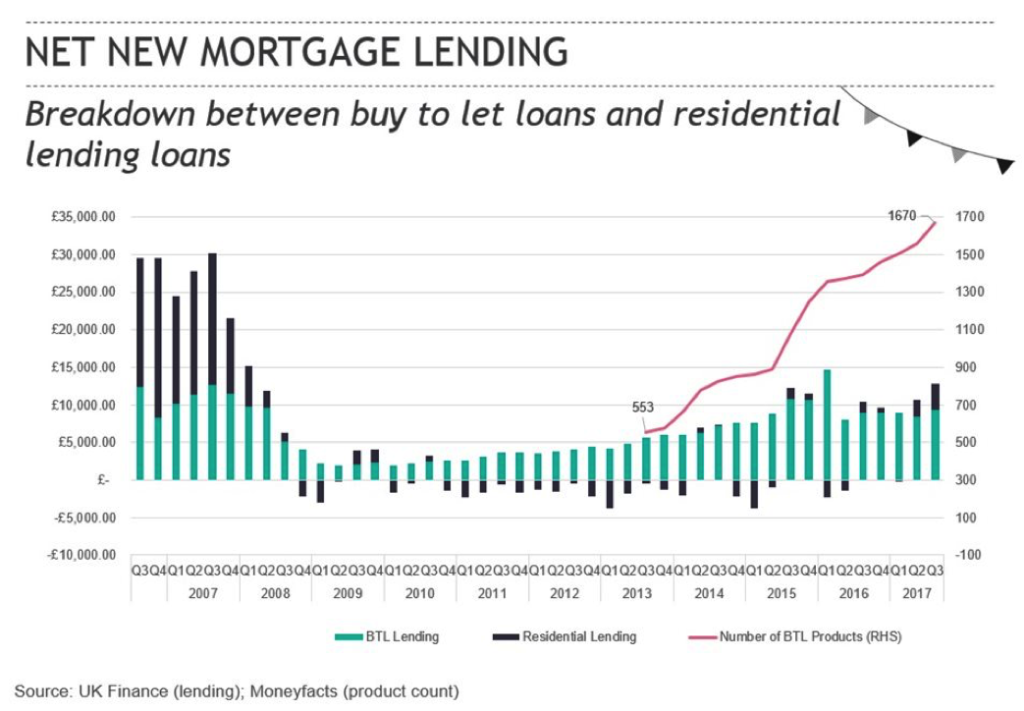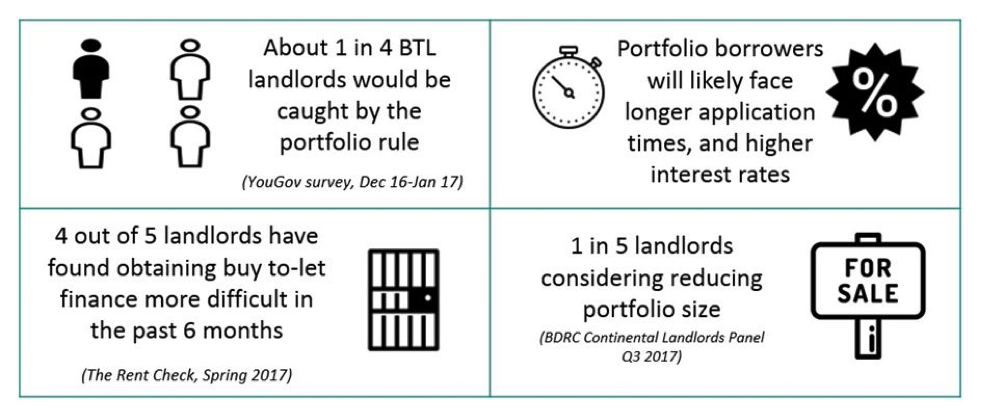UK Finance Expert Explains Lending Changes for Portfolio Landlords

Back in November last year, we were proud to partner with London estate agent Portico for its annual London Landlord Seminar. One of the first experts to speak at the event was Carla Sateriale, the Senior Policy Analyst at UK Finance. She explained the recent lending changes for portfolio landlords – we have all of the information she had to offer…
A host of industry experts gathered at the event to share their insight on some hot property investment topics.
Sateriale and her team represent the first charge mortgage market, which means that they have a good dialogue with the Bank of England (BoE). Consequently, Sateriale was able to share some interesting insight into the latest lending changes for landlords, including:
- Why the BoE’s Prudential Regulation Authority (PRA) is targeting buy-to-let lending
- Why the PRA is targeting mortgaged portfolio landlords in particular
- How the typical landlord will be affected by these changes
Here’s what she had to say:
Why is the PRA targeting buy-to-let?
We’ve already seen that the Government isn’t shy about introducing tax changes that specifically target buy-to-let landlords. But why did the PRA bring in further rule changes? Isn’t the BoE supposed to be apolitical? And, as an arm of the BoE, shouldn’t the PRA also be independent?
Sateriale took us back to 2015, when the PRA started to conduct an internal review of the buy-to-let mortgage sector. What it did was examine the growth plans of 31 lenders, which made up 90% of the market. It looked at the medium-term plans of these lenders for expanding their net lending, and the underwriting criteria that were needed to do that.
At the time, it was common underwriting practice for a loan to have a 125% interest cover ratio, under a 5% interest rate.
Sateriale explained that, by extrapolating the growth plans of the market as a whole, the PRA concluded that there was a significant risk that lenders would have to relax their underwriting standards in order to hit their growth plans.
This prompted the micro-prudential intervention that was introduced last year. Before anyone needed to ask, Sateriale explained that a micro-prudential intervention means that the rules are about ensuring that mortgage lenders can withstand economic shocks.
She said: “It has nothing to do with protecting borrowers, or fairness in the housing market – it’s about ensuring that the debt banks are issuing is robust.
“Now, the obvious follow on question is: was there data to justify this intervention? Here I’m going to give you some background on the market context.”
Buy-to-let vs. residential loans
If you’ve been in the market for buy-to-let mortgages over the past several years, no doubt you’ve noticed that there is substantially more choice in both products and lenders now than there was a few years ago.

UK Finance Expert Explains Lending Changes for Portfolio Landlords
Sateriale highlighted the graph above, which shows the breakdown between buy-to-let loans and residential mortgages, using data from Moneyfacts.co.uk. The pink line in the chart shows the number of buy-to-let products, plotted on the right axis. Although the data only starts in 2013, you can see pretty clearly that the number of products available has grown massively in recent years. Sateriale explained that this growth reflects the importance of property investors in helping to drive net mortgage lending.
What you may not be aware of, however, is that buy-to-let played an ever more important role for mortgage lenders over the past few years. The height of the bars in the chart shows net lending each quarter over the past decade. The bright blue portion shows how much was due to buy-to-let lending, while the indigo portion shows how much was down to residential lending.
You can see that, in the quarters before the financial crisis, net new lending was driven mostly by residential lending. But, since then, residential mortgage lending has only made a small contribution to net lending, and, in many quarters, made a negative contribution.
So, from a mortgage lender’s point of view, buy-to-let has been absolutely crucial for growth, which illustrates the PRA’s concern.
Why are portfolio landlords being singled out?
The bigger question for most landlords is why portfolio landlords – defined as those with four or more mortgaged properties – are being singled out in the new rules, and why four was chosen as the threshold, and not, say, ten properties.
Sateriale explained: “The reasoning behind the portfolio landlord rule is the perception that the more heavily encumbered a portfolio is, the more financially precarious it becomes, and, therefore, more likely to fall into arrears.”
This intuitively seems sensible, but there hasn’t been actual data that suggests that landlords with larger portfolios are more affected by arrears issues than those with fewer properties.
However, there might be reason for the PRA to be concerned with the pace at which investors have grown their portfolios, and how that may square with lenders’ risk appetite.
Looking at survey research, Sateriale pointed out that, between 2010-16, the proportion of single property landlords fell from about 80% of all investors to 60%. Meanwhile, the proportion of landlords with two to four properties had risen by the same amount. So, we can take a guess and say that there are a number of landlords who owned a single investment property just a few years ago, who have now collected a few more quite quickly.
Sateriale went on to explain that the PRA may be concerned about this, because it’s unlikely that a landlord will get all of their mortgage financing from a single lender; the market for buy-to-let financing has quickly become very competitive, and, while you may have fit a particular lender’s risk appetite when you originally took out a loan, if you’ve expanded and re-leveraged your portfolio in the interim period, your original lender might view your current risk profile a bit differently. That’s particularly true if you only have a short history of letting property, or if you find yourself in a higher tax bracket as a result of recent tax changes.
So, while the new rules will undoubtedly complicate the application and underwriting process for many lenders, it will also provide some assurance to the PRA that they will all be making underwriting decisions with the same information.
How will the new PRA rules affect landlords?

How Landlords are Reacting to the Changes
Examining a YouGov survey conducted around this time last year, Sateriale highlighted that around one in four buy-to-let landlords would be classed as portfolio landlords, which means that they’ll have to go through a longer underwriting process that takes a look at their entire property business when applying for a mortgage.
Sateriale explained that landlords can therefore expect to experience a longer application process, to pay slightly higher interest rates and have a narrower range of potential lenders.
She said: “A lot of borrowers have reported that the refinancing process has become more difficult recently, and some are worried about being buy-to-let mortgage prisoners. In theory, there shouldn’t be a problem of mortgage prisoners. The PRA guidance has an explicit carve out to exempt pound for pound remortgaging from the stricter rules. Nonetheless, if you’ve expanded your portfolio since the last time you re-financed, lenders may still be interested in applying the wider assessment, even if it’s not a requirement.”
Sateriale ended her speech by stating that about one in five landlords are thinking of selling all or part of their portfolio at present, which is a relatively new market development, potentially fuelled by market conditions and the latest PRA changes.
To help you get to grips with the new portfolio landlord rules, we have created a helpful guide: https://www.justlandlords.co.uk/news/portfolio-landlord-underwriting-changes/
While it’s certainly true that the buy-to-let market is changing, property is still a fantastic long-term investment – especially compared with other asset classes. Currently, we may be in a dip, but it’s completely natural for the market to have its ups and downs, and the market is expected to smooth out. After all, the population is growing rapidly, demand for housing continues to boom, but yet we’re suffering from an acute property shortage. Has your sentiment to buy-to-let changed with the new rules?




